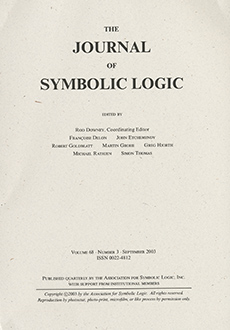Abstract
Each relational structure X has an associated Gaifman graph, which endows X with the properties of a graph. If x is an element of X, let Bn(x) be the ball of radius n around x. Suppose that X is infinite, connected and of bounded degree. A first-order sentence φ in the language of X is almost surely true (resp. a.s. false) for finite substructures of X if for every x∈ X, the fraction of substructures of Bn(x) satisfying φ approaches 1 (resp. 0) as n approaches infinity. Suppose further that, for every finite substructure, X has a disjoint isomorphic substructure. Then every φ is a.s. true or a.s. false for finite substructures of X. This is one form of the geometric zero-one law. We formulate it also in a form that does not mention the ambient infinite structure. In addition, we investigate various questions related to the geometric zero-one law.
Citation
Robert H. Gilman. Yuri Gurevich. Alexei Miasnikov. "A geometric zero-one law." J. Symbolic Logic 74 (3) 929 - 938, September 2009. https://doi.org/10.2178/jsl/1245158092
Information





